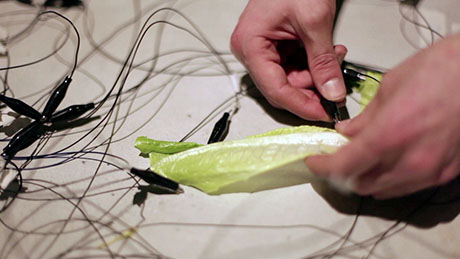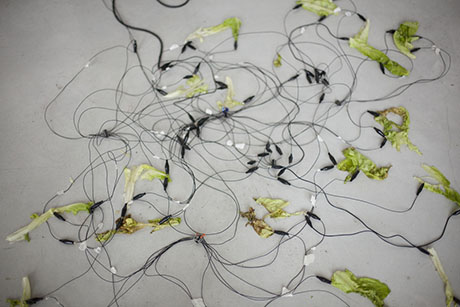A couple of months ago, Leonardo Amico, an interaction designer based at Fabrica, connected romaine lettuce leaves into an electrical circuit, attached a CMOS logic chip and a couple of oscillators to transform the voltage into tone, and recorded the result.
Although lemons and potatoes are better known for their science-fair double life as batteries, fresh lettuce also contains the electrolytes required to generate current across a circuit. As it dies its lingering post-harvest death, however, lettuce, like all produce, continues to respire, desperately consuming its own carbohydrate reserves as its cell membranes break down and its water content evaporates.


IMAGES: Processing Decay, Leonardo Amico, via Flickr.
Without the life-support of artificial refrigeration and modified atmosphere storage, the result, in only a matter of days, is a wilted, brown, weeping mess. In technical terms, the lettuce has experienced massive electrolyte leakage.
The visual, tactile, and olfactory signals of a lettuce’s tissue breakdown and death will be familiar to anyone who has overlooked a bag of leaves or head of iceberg in the bottom drawer of their fridge—an annoyance rather than a minor tragedy. Listening to the sound of decomposition, however, is curiously affecting. As the lettuce’s cell structure and water content changes, so, too, does its voltage, and thus its sonic output, from the bright, tinny, and surprisingly speedy pulse of a crisp, green leaf to the mournful, fog-horn honks of a five-day-old compost-pile candidate.
According to National Resources Defense Council report (PDF) issued last year, American households throw out, on average, a quarter of the food they purchase, with fruit and vegetable spoilage cited as the primary reason, and poor visibility in refrigerators responsible for at least part of the problem. If, in the logic-chipped smart household appliances of the future, lettuce death could modulate a refrigerator’s hum, singing its own end with a reproachful, rallentando drone, might we waste less food?
4 Comments
I’ve begun storing my fruits and veggies in the fridge door and they keep longer. My apartment is very warm and produce left out spoils quickly. I would like this feature for the winter months. I wonder if someone could design an app or stand-alone device for those among us (renters) who can’t easily replace their fridges?
It’s a good point, though. I personally find the more fruit & veg I can keep out of the fridge, the more I eat (I quite like these anti-fridge designs: https://www.ediblegeography.com/the-anti-fridge/)
As ubiquitous sensing becomes cheaper (internet of things, etc.) I assume we are moving in the direction of smart fridges with ethylene detectors, etc. that will alert you in some way when the food is on the verge, so you can get a text from your aging lettuce. Or a guilt-inducing voicemail, of just its last laboured gasps?
I apologise for missing the point entirely (and it is a well-made point – although the keening of decaying produce in my fridge would almost certainly drive me towards a steady diet of take-out!), but how can you design a better fridge?
If “poor visibility in refrigerators” could be solved, think of the benefits, not just in terms of the reduction in wastage, but in financial savings, improved nutrition as people are less put off the idea of cooking from scratch, and reduced methane pollution from decaying organic waste.
A very interesting idea.